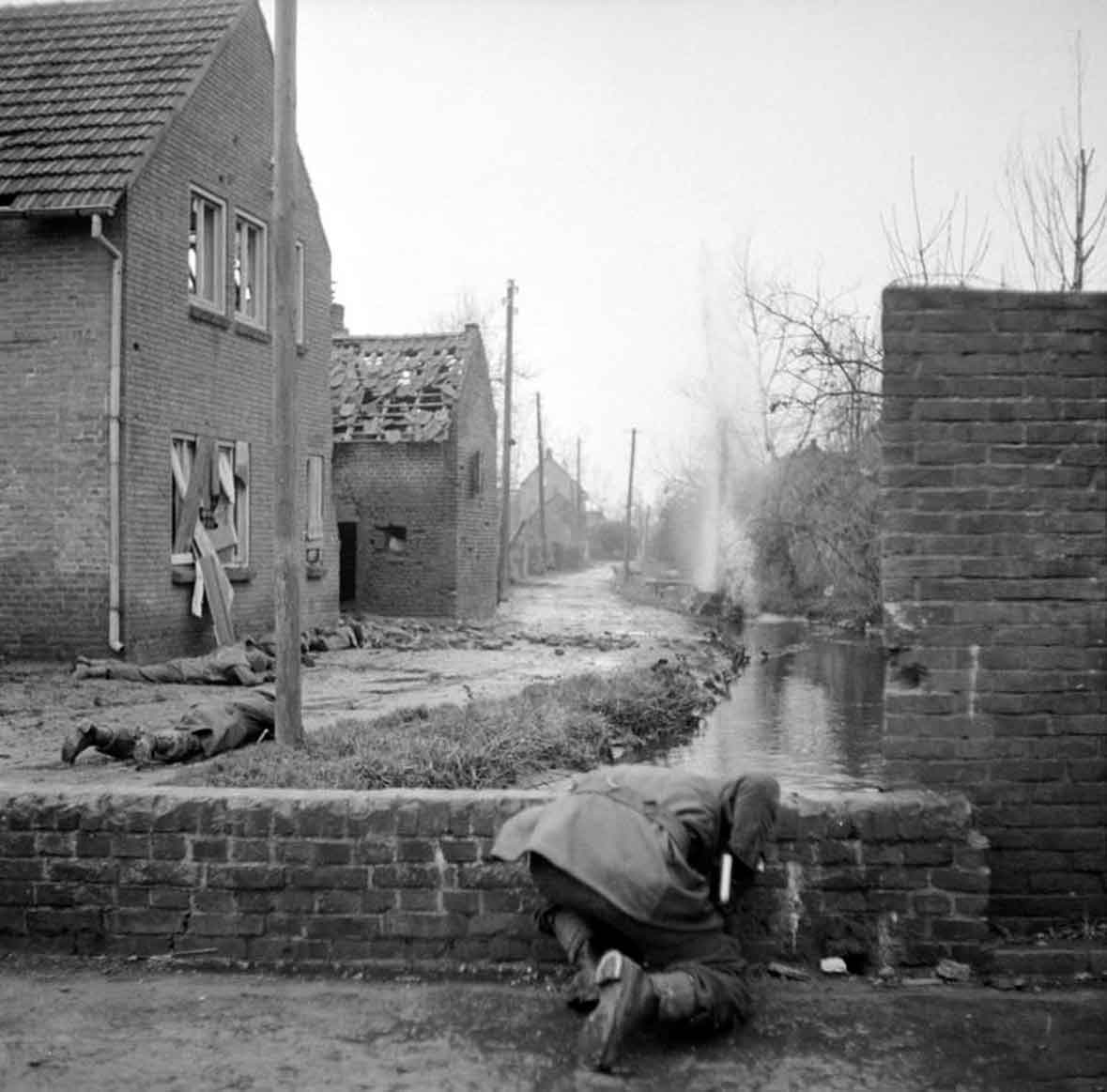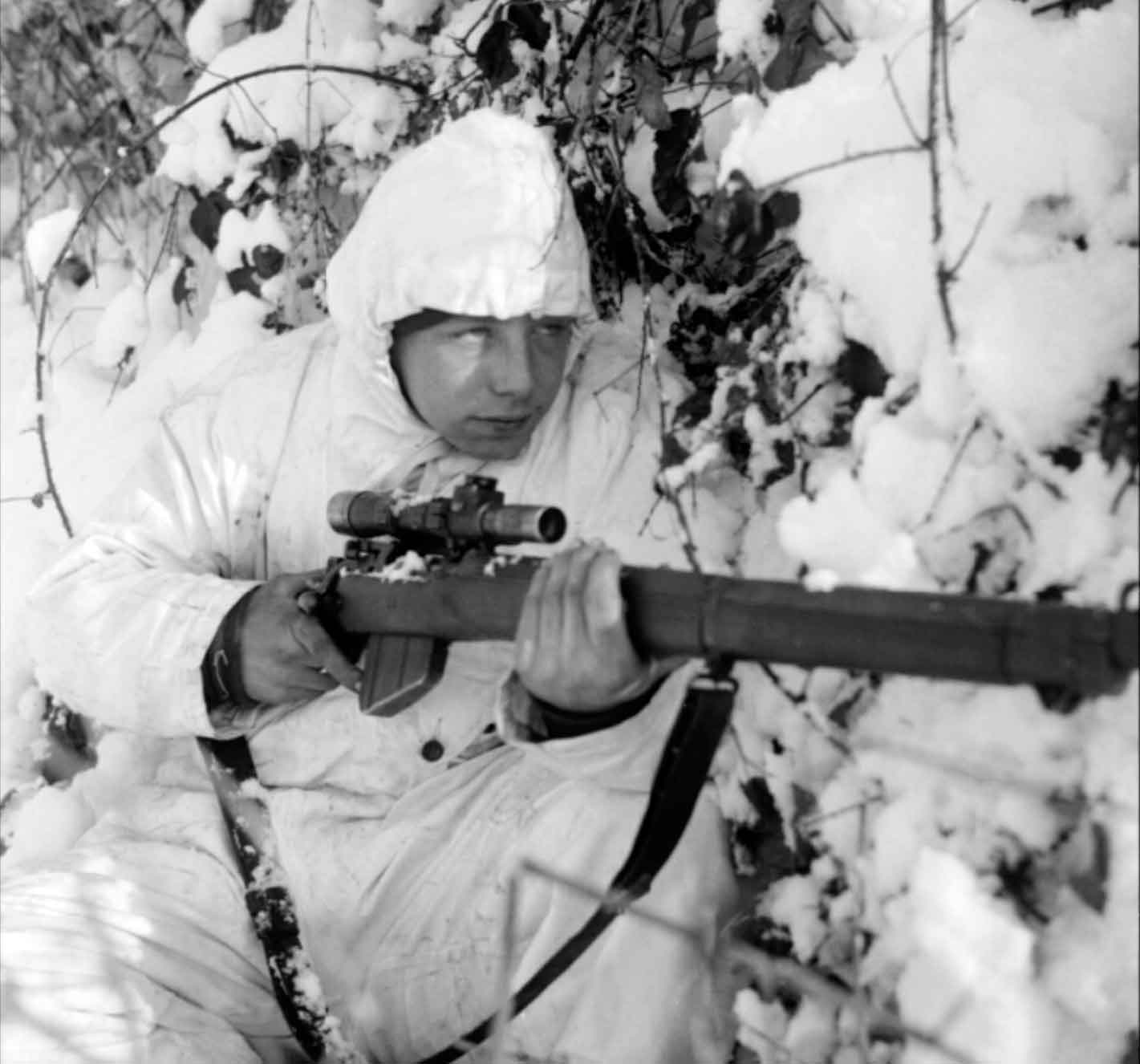| Britain’s Battle of the Bulge:
The Story, Part Two
By Vincent Kamer
June 2021
 The story begins here. The story begins here.
By this time there was a good bit of panic in the Allied command. To their credit the American frontline troops had been able to significantly slow down the German offensive in many places. After being slow to comprehend the nature of the offensive on the 16th, Dwight Eisenhower, the Supreme Commander of the Allied Expeditionary Force, Omar Bradley, the commander of U.S. 12th Army Group, and Courtney Hodges, the commander of U.S. 1st Army, had reacted swiftly in sending reserves from all levels and most famously the 101st Airborne Division which would hold the German attack on Bastogne. Eisenhower also realized that this would not be enough, so on 20 December he decided to split off the northern part of Bradley’s 12th Army Group – U.S. 9th Army and most of U.S. 1st Army – and transfer it to 21st Army Group commanded by British Field Marshal Bernard Montgomery. Not a very popular move among his commanders, but absolutely the right decision.
Apart from the logistical advantages and unifying command in the most exposed sector, putting Montgomery in charge also pulled in the possibility to deploy the British reserves, in particular XXX Corps which had been resting and refitting following the Market-Garden campaign. In his typical methodical fashion, after meeting his senior commanders Montgomery first decided to stabilize the front, redeploying VII U.S. Corps from 9th to 1st Army. VII Corps contained two of the best U.S. armored divisions, the super heavy 2nd and 3rd. These two together with 84th Infantry Division were rushed over to plug the gap opening up around Marche-en-Famenne.
Similarly, Montgomery organized the rapid arrival of XXX Corps. Monty had been in command of the 3rd Division in Belgium in May 1940 and knew one the reasons they had lost that battle is because they had to turn and run. Another Dunkirk would not happen on his watch. On the 19th he had already anticipated by ordering 29th Armoured Brigade, which was resting and refitting around Ypres, to send advance parties to hold the Meuse crossings from Givet to Namur. The bulk of the brigade followed over the next two days, after passing by Brussels to pick up their “old Shermans” which they had turned in pending replacement by new Comet tanks. By the 22nd a nice welcoming committee had been organized in a triangle between Marche, Rochefort and Dinant. Two other armoured brigades were sent further east to backstop the Meuse crossings between Namur and Liège. Further infantry forces were called up from 53rd Welsh Division and 51st Highland Division, with 6th Airborne Division, of Pegasus Bridge fame, being trucked in from England. But these would arrive only after the next German offensive operations.

Troops of the Rifle Brigade take cover as mortar bombs fall.
After refuelling, 2nd Panzer Division set off on the 22nd (already two days overdue) to try and get over the Meuse. Next stop on the map was Marche-en-Famenne, but they found this held strongly by U.S. forces who even counterattacked. Not wanting to get into a slog, advance elements screened Marche and moved west to the village of Hargimont. The plan was to make a lunge for the Anseremme railway bridge south of Dinant on the 23rd. Lunge they did, managing to infiltrate a little further along small roads. But they were literally running out of road.
And then on the 23rd they woke up to clear skies. At the airbase of Florennes thirty-odd miles west of the 2nd Panzer spearhead, 370th and 474th Fighter Groups were scrambled and started bombing everything they could spot. Still the lead elements of 2nd Panzer Division went forward. But when they came upon the Sherman Fireflies of the 3rd Royal Tank Regiment their journey ended.
On the 24th all hell broke loose, as the German forward forces were pounded by massive artillery barrages, six fighter groups milled overhead bombing and strafing everything in sight and the combined force of the British 29th Armoured Brigade and U.S. 2nd “Hell on Wheels” Armored Division tore them to shreds. The Germans went on the defensive, and often the telling of the story ends here. The Allies won the day and the rest is history. In doing so, you would skip over some of the hardest fighting of the Battle of the Bulge. Clearly Objective Antwerp was out. The Germans were on the defensive. Outnumbered, but dug into some of the best defensive terrain in Belgium in some of the worst weather conditions possible: deep snow and freezing temperatures.
After stopping the German offensive, Montgomery reinforced and reorganized his forces during the next 10 days for a major offensive. This started on 3 January, with the U.S. XVIII Airborne Corps in the east striking on both sides of the river Salm, his most powerful force the U.S. VII Corps in the center, striking towards Houffalize in order to link up with Patton’s Third U.S. Army. And on the west side, his British XXX Corps would strike from the south-west at the German salient.

The spring-loaded PIAT would actually stop a tank. Sometimes.
XXX British Corps teamed up 6th Airborne Division with 29th Armoured Brigade in the west, from south of Rochefort to west of Marche, and 53rd Infantry Division with 33rd Armoured Brigade in the east, from Marche to Hotton. All of this supported with plentiful corps artillery. Facing them were the remains of the 2nd, 9th and 116th Panzer Divisions. These had been reorganized into LVIII Panzer Corps. For days these forces would fight over small villages like Bure and Grimbiémont.
Bure was the objective of the 13th (Lancashire) Parachute Battalion, whose battle motto was “Win or Die” or adding a touch of Shakespeare: “they win or die who wear the rose of Lancashire.” Which is pretty much what they did in some of the fiercest fighting any of these veteran troops had ever witnessed. By 7 January the 53rd Infantry Division was so worn down that it was withdrawn and replaced by the 51st Infantry Division. And still they pushed on. The salient to nowhere was starting to buckle, so the Germans started withdrawing, with a first withdrawal occurring on 9 January.
As the salient started to shrivel, forces were withdrawn for rest and refit or other more important assignments. What remained of 2nd Panzer Division was withdrawn from the front on 10 January and crossed the bridge at Dasburg back into the Reich on the 19th, never to become a fully capable fighting unit again. On 13 January 29th Armoured Brigade was ordered back to Ypres and would finally get their Comet tanks. On 14 January the Germans instituted a further withdrawal enabling the Allied forces north and south of the salient to close their pincers at Houffalize, but the pocket was pretty empty and there was not much of a catch to be had. XXX Corps was withdrawn on 16 January out of the Battle of the Bulge which they had helped shape with some crucial interventions and also out of many history books, who have hardly acknowledged the British contribution to this battle.
For the U.S. forces the slog was not yet over. They would continue to fight the Germans for every inch of the Ardennes until the Bulge was no more at the end of January. For the withdrawn forces of the German Army there would be no rest. Either they would continue to fight on the Western Front or they would be shipped off to try and stabilize the critical situation in Hungary, especially around Budapest, or be sent to the East to face the Russian Juggernaut. Stalin had opened up his latest winter offensive on 12 January.

Win or Die. A sniper of the 13th Lancashire Parachute Battalion. Bure, January 1945.
The last chance offensive was over. Tactically there had been quite some German successes. The Battle of the Bulge is the bloodiest battle the U.S. Army ever fought. The U.S. Army lost (depending on the source you consult) about 90,000 men of whom 19,000 were killed in action. The British and Canadian armies lost about 1,400 men of whom 200 were killed. The Germans lost about 82,000 with 13,000 dead. For armored vehicles the loss difference is even bigger with Allied losses of around 2000 armored vehicles, whereas German losses were about 600.
The Ardennes are not a nice place to fight in in the midst of winter, that is why no one had attacked there before during that time of year. However, the Germans had no way to replace these losses anymore – after a huge effort they had started the campaign with 700 tanks and assault guns. And to put the US losses into perspective: at the average rate of deaths incurred during the U.S. military action in Afghanistan over the last 20 years, that war would need to continue for another 145 years before the number killed in action would be the same. No wonder the Battle of the Bulge has such a place in U.S. history.
Strategically the result was a resounding failure. Hitler never came close to splitting the Allies. The best he got was some squabbling between commanders and the press when Monty was assigned his expanded command and subsequently gave “an unfortunate press conference” – nothing more than a storm in a tea-cup really.
For this Hitler had mobilized the best he had left and sent it west. Win or Die. Five months later he was dead. One of the consequences of committing so many forces west is that he actually made it easier for the Soviets to invade Germany. If he had not done so it is likely that the Red Army would not have made it to Berlin before the Western Allies. Not that it would have changed much about Hitler dying. Fate is a fickle friend it seems.
You can order Britain's Battle of the Bulge right here.
Please allow an extra two weeks for delivery.
Sign up for our newsletter right here. Your info will never be sold or transferred; we'll just use it to update you on new games and new offers.
|
